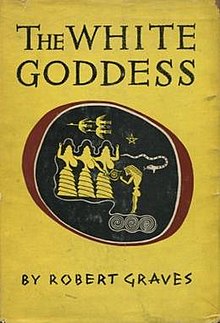The White Goddess

First US edition
|
|
| Author | Robert Graves |
|---|---|
| Country | United Kingdom |
| Language | English |
| Genre | Mythology, Poetry |
| Publisher |
Faber & Faber (UK) Creative Age Press (US) |
|
Publication date
|
1948 |
The White Goddess: a Historical Grammar of Poetic Myth is a book-length essay on the nature of poetic myth-making by author and poet Robert Graves. First published in 1948, the book is based on earlier articles published in Wales magazine, corrected, revised and enlarged editions appeared in 1948, 1952 and 1961. The White Goddess represents an approach to the study of mythology from a decidedly creative and idiosyncratic perspective. Graves proposes the existence of a European deity, the "White Goddess of Birth, Love and Death," much similar to the Mother Goddess, inspired and represented by the phases of the moon, who lies behind the faces of the diverse goddesses of various European and pagan mythologies.
Graves argues that "true" or "pure" poetry is inextricably linked with the ancient cult-ritual of his proposed White Goddess and of her son.
Many of the book's themes are also explored in a fictional form, through his depiction of a future society dominated by Great Goddess religion in the 1949 novel Seven Days in New Crete.
Graves first wrote the book under the title of The Roebuck in the Thicket in a three-week period during January 1944, only a month after finishing The Golden Fleece. He then left the book to focus on King Jesus a historical novel about the life of Jesus. Returning to The Roebuck in the Thicket, he renamed it The Three-Fold Muse, before finishing it and retitling it as The White Goddess. In January 1946 he sent it to the publishers, and in May 1948 it was published in the UK, and in June 1948 in the US, as The White Goddess: a Historical Grammar of Poetic Myth.
Graves described The White Goddess as "a historical grammar of the language of poetic myth." The book draws from the mythology and poetry of Wales and Ireland especially, as well as that of most of Western Europe and the ancient Middle East. Relying on arguments from etymology and the use of forensic techniques to uncover what he calls 'iconotropic' redaction of original myths, Graves argues for the worship of a single goddess under many names, an idea that came to be known as "Matriarchal religion" in feminist theology of the 1970s.
...
Wikipedia
